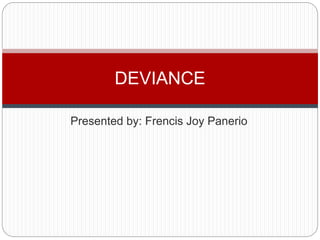Deviant Behavior
- 1. DEVIANCE Presented by: Frencis Joy Panerio
- 2. sample 1.0
- 3. Sample 1.1
- 4. Sample 1.2
- 5. ï Deviance - describes actions or behaviors that violate social norms, including formally enacted rules as well as informal violations of social norms ï Norms - are rules and expectations by which members of society are conventionally guided. NOTE: Social norms differ from culture to culture or it is relative.
- 6. Theories on Deviant Behavior
- 7. Structural Strain Theory/Anomie âĒ This theory explains deviance as the outcome of social strains due to the way the society is structured. âĒ Robert Merton used the term to describe the differences between socially accepted goals and the availability of means to achieve those goals âĒ It is when the goals and means are not in balance with each other that deviance is likely to occur. This imbalance between cultural goals and structurally available means can actually lead an individual into deviant behavior. Robert K. Merton
- 8. 5 Categories of People: ï Conformist - are people who believe in both the established cultural goals of society as well as the normative means for attaining those goals. ï Ritualists - are individuals who do not believe in the established cultural goals of society, but they do believe in and abide by the means for attaining those goals.
- 9. ï Innovators - are those individuals that accept the cultural goals of society but reject the conventional methods of attaining those goals ï Retreatists - are individuals who reject both the cultural goals and the accepted means of attaining those goals. ï Rebels - not only reject both the established cultural goals and the accepted means of attaining those goals, but they substitute new goals and new means of attaining those goals.
- 10. Labeling Theory âĒ The theory explains deviance as a social process whereby some people are able to define others as deviant. It emphasizes that the deviance is relative -- it is not until a label is given to someone by someone else in a position of social power that the person actually "becomes" a deviant. âĒ Labeling theory is the most important approaches to understanding deviant and criminal behavior within sociology. Frank Tannenbaum Howard S. Becker
- 12. Differential-association Theory âĒ According to this theory, the environment plays a major role in deciding which norms people learn to violate. âĒ Socializing agents - parents, teachers, ministers, family, friends, coâworkers, and the media âĒ Criminal behavior is learned
- 13. THANK YOU ï References: http://sociology.about.com/od/Sociological-Theory/a/Structural- Strain-Theory. http://www.cliffsnotes.com/sciences/sociology/deviance-crime-and-social- control/theories-of-deviance http://ww2.valdosta.edu/~klowney/devtheories.htm http://en.wikipedia.org/wiki/Deviance_(sociology)













